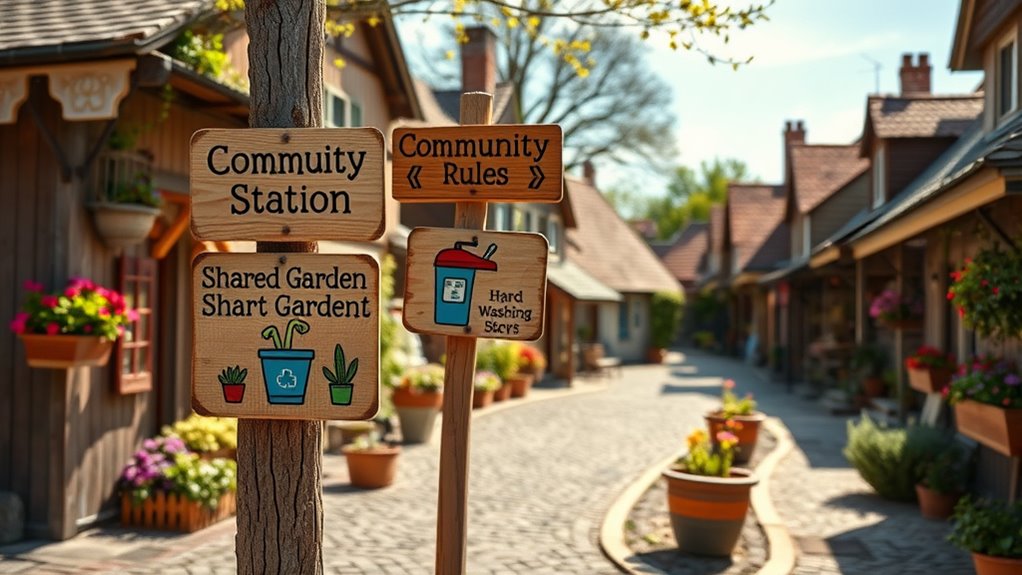In shared tiny villages, community rules are crucial to guarantee everyone lives peacefully and cooperates smoothly. You should participate in chores, use automation tools to stay organized, and respect quiet hours to keep noise levels down. Building trust and respecting one another helps create a positive environment where everyone feels safe and valued. By following these guidelines, you’ll contribute to a harmonious community—if you want to learn more, keep exploring these essential principles.
Key Takeaways
- Establish clear guidelines for sharing responsibilities like chores and maintenance to promote teamwork.
- Use automation tools to coordinate tasks and keep residents informed about communal activities.
- Set quiet hours, especially at night, to minimize noise disturbances and maintain a peaceful environment.
- Encourage participation in community activities to build trust and foster a sense of collective well-being.
- Respect individual needs and promote open communication to prevent conflicts and ensure a harmonious living space.

In tiny villages, community rules are the foundation that keeps everyone working together smoothly. These rules help guarantee that daily life remains peaceful and that everyone’s needs are respected. One of the most important aspects of these rules is sharing responsibilities. When you live in a small community, you can’t rely on others to handle everything. Instead, you’re encouraged to pitch in with chores, maintenance, or community events. For example, you might be asked to help with watering shared gardens, cleaning communal spaces, or organizing gatherings. Sharing responsibilities fosters a sense of teamwork and keeps the village running efficiently. It also ensures that no single person bears the entire burden, which helps prevent resentment and burnout. When everyone contributes, the village becomes a more welcoming and cooperative place to live. Additionally, implementing simple automation tools can help streamline communal tasks and reminders, making cooperation even easier.
Alongside sharing responsibilities, noise regulations play a critical role in maintaining harmony. In tiny villages, where homes are close together, loud noises can quickly disturb neighbors and disrupt peace. Community rules often specify quiet hours, particularly in the evenings and early mornings, to give everyone the chance to rest and enjoy their personal space. You’re expected to keep noise levels in check, especially during these times, whether it’s loud music, parties, or late-night chores. Respecting noise regulations shows consideration for your neighbors’ comfort and helps prevent conflicts. If you’re hosting a celebration or working on a project that might generate noise, it’s essential to communicate with neighbors beforehand and keep sound levels reasonable. These rules aren’t meant to restrict enjoyment but to balance individual freedom with collective well-being. When everyone abides by noise regulations, the community remains peaceful and everyone can feel safe and relaxed in their environment.
Living in a tiny village means understanding that your actions impact everyone around you. Sharing responsibilities and respecting noise regulations aren’t just about following rules—they’re about building trust and fostering a sense of community. When you actively participate in shared chores and are mindful of noise levels, you contribute to a positive atmosphere where everyone feels valued and comfortable. These rules help prevent misunderstandings and ensure that the village remains a harmonious place to live. You’ll find that a little effort on your part goes a long way in strengthening bonds within your community. As a result, your tiny village becomes more than just a collection of homes; it transforms into a genuine community where cooperation, respect, and shared responsibility thrive.
Frequently Asked Questions
How Are Disputes Between Neighbors Typically Resolved?
When disputes arise, you typically resolve them through neighbor mediation, where both parties discuss their issues with a neutral facilitator. This conflict resolution approach encourages open communication and understanding, helping you find common ground. If mediation doesn’t work, you might involve a community leader or use formal channels. Staying respectful and focused on solutions guarantees that conflicts are resolved amicably, maintaining harmony in your tiny village.
What Happens if Someone Breaks the Community Rules?
Breaking community rules is like throwing a stone in a calm pond—you’ll cause ripples. When you do, the neighborhood typically engages in conflict resolution, addressing the issue directly or through mediation. The rule enforcement process then kicks in, ensuring everyone follows agreed-upon guidelines. If violations persist, consequences like warnings or restrictions happen, but the goal remains restoring harmony and maintaining a cooperative living environment.
Are Pets Allowed Within the Tiny Village Communities?
Pets are generally permitted within the tiny village communities, but you should always verify the specific pets policy for your area. Some communities have animal restrictions like size limits or banning certain breeds. Make sure you follow these rules to keep everyone happy and ensure your pet’s well-being. Always communicate with community coordinators if you plan to bring a pet, so you stay within the guidelines and avoid any issues.
How Is Emergency Access Managed in Shared Spaces?
You might find it surprising, but emergency access in shared spaces is carefully coordinated through designated shared pathways. These pathways are kept clear at all times, ensuring quick response times when emergencies occur. You’re encouraged to stay aware of signage and access points, as they’re strategically placed for easy entry. Regular drills and clear communication help everyone understand how to maintain unobstructed emergency access, keeping your tiny village safe and responsive.
Can Residents Customize Their Tiny Home Exteriors?
Yes, you can customize your tiny home exterior, but you’ll need to follow the community aesthetic guidelines. These rules help maintain a cohesive look across the village, so your personal touches should complement the overall design. Before making any changes, check with the community management to guarantee your home exterior customization aligns with the established standards. This way, you can express your style while respecting shared space harmony.
Conclusion
Embracing the community rules gently guides your journey through shared living, helping everyone find harmony amid the tiny village’s quiet rhythm. These guidelines serve as delicate threads weaving trust and respect, fostering a space where differences are appreciated and coexistence blooms naturally. When you honor these unspoken boundaries, you contribute to a subtle, ongoing dance of understanding. Ultimately, it’s in these gentle agreements that the true spirit of the village quietly flourishes, welcoming all with open hearts.







